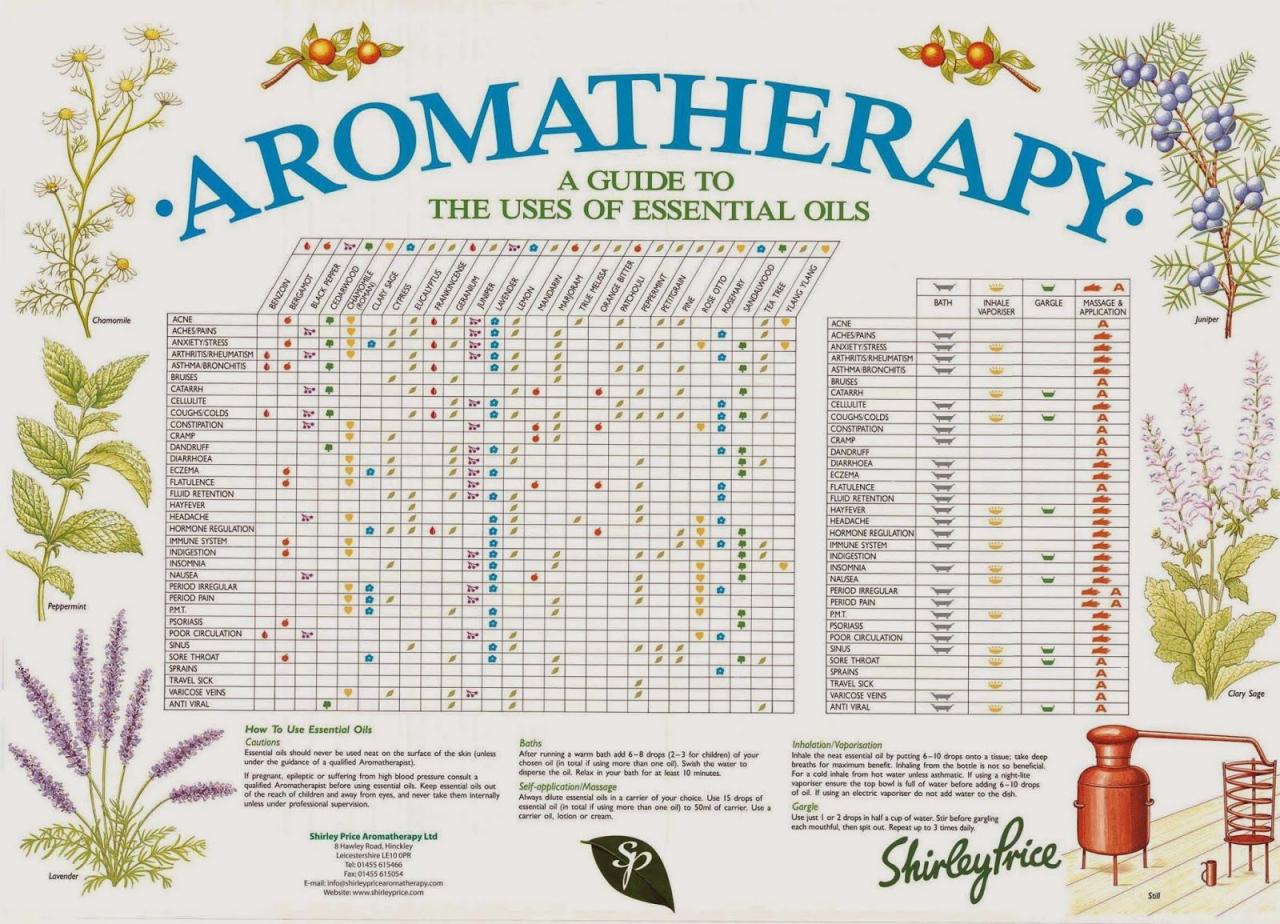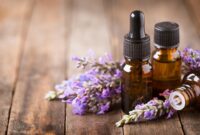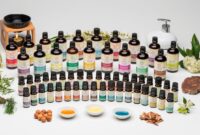Aromatherapy oils guide – Welcome to the realm of aromatherapy oils, where nature’s fragrant essences intertwine with the art of healing. In this comprehensive guide, we embark on a journey to discover the history, benefits, and applications of these aromatic treasures.
From ancient civilizations to modern-day practices, aromatherapy has stood the test of time, offering a holistic approach to well-being. With their ability to uplift spirits, soothe minds, and promote physical health, essential oils have become an indispensable part of natural healing.
Introduction to Aromatherapy Oils
Aromatherapy is the practice of using essential oils for therapeutic purposes. Essential oils are concentrated plant oils that retain the natural smell and flavor of their source. The history of aromatherapy dates back to ancient Egypt, where essential oils were used in religious ceremonies, cosmetics, and medicine.
Aromatherapy oils are believed to have a variety of benefits, including reducing stress, improving sleep, boosting mood, and relieving pain. They can be used in a variety of ways, including inhalation, topical application, and massage.
Types of Aromatherapy Oils
There are many different types of aromatherapy oils, each with its own unique properties. Some of the most popular oils include:
- Lavender oil: Known for its calming and relaxing effects.
- Peppermint oil: Known for its invigorating and stimulating effects.
- Tea tree oil: Known for its antiseptic and antibacterial properties.
- Eucalyptus oil: Known for its decongestant and expectorant properties.
- Lemon oil: Known for its uplifting and refreshing effects.
Types of Aromatherapy Oils: Aromatherapy Oils Guide

Aromatherapy oils are natural plant extracts that are used for their therapeutic properties. They can be used in a variety of ways, including inhalation, topical application, and massage.
There are many different types of aromatherapy oils available, each with its own unique scent and benefits. The following table lists 10 of the most popular aromatherapy oils and their uses:
| Oil Name | Source | Scent | Benefits |
|---|---|---|---|
| Lavender | Lavandula angustifolia | Floral, herbaceous | Relaxing, calming, sleep-promoting |
| Peppermint | Mentha piperita | Minty, refreshing | Energizing, stimulating, headache-relieving |
| Eucalyptus | Eucalyptus globulus | Camphoraceous, woody | Decongestant, expectorant, antimicrobial |
| Tea tree | Melaleuca alternifolia | Spicy, medicinal | Antibacterial, antifungal, antiviral |
| Lemon | Citrus limon | Citrusy, refreshing | Uplifting, mood-boosting, antibacterial |
| Frankincense | Boswellia carterii | Woody, spicy | Anti-inflammatory, pain-relieving, wound-healing |
| Rosemary | Rosmarinus officinalis | Herbaceous, camphoraceous | Stimulating, memory-enhancing, hair growth-promoting |
| Ylang-ylang | Cananga odorata | Floral, sweet | Relaxing, aphrodisiac, mood-boosting |
| Bergamot | Citrus bergamia | Citrusy, floral | Uplifting, calming, skin-soothing |
| Clary sage | Salvia sclarea | Herbaceous, floral | Balancing, hormone-regulating, pain-relieving |
How to Use Aromatherapy Oils
Aromatherapy oils can be used in a variety of ways to promote relaxation, improve mood, and alleviate physical ailments. The most common methods of using aromatherapy oils include diffusing, topical application, and inhalation.
Diffusion
Diffusion is a method of dispersing essential oils into the air. This can be done using a diffuser, which is a device that uses heat or ultrasonic waves to break down the oil into tiny particles that can be inhaled.
Diffusing essential oils can help to create a calming or uplifting atmosphere in a room, and can also be used to purify the air.
Topical Application
Topical application involves applying essential oils directly to the skin. This can be done by adding a few drops of oil to a carrier oil, such as jojoba or coconut oil, and then massaging the mixture into the skin. Topical application of essential oils can be used to relieve muscle pain, improve skin health, and promote relaxation.
Inhalation
Inhalation is a simple method of using aromatherapy oils that involves inhaling the scent of the oil directly from the bottle or from a diffuser. This can be done by taking a few deep breaths of the oil, or by placing a few drops of oil on a tissue or handkerchief and inhaling the scent.
Safety Precautions
When using aromatherapy oils, it is important to take certain safety precautions to avoid any potential side effects. These precautions include:
- Always dilute essential oils with a carrier oil before applying them to the skin.
- Do not ingest essential oils.
- Avoid using essential oils on children under the age of 6.
- If you are pregnant or breastfeeding, consult with your doctor before using essential oils.
- If you have any underlying health conditions, consult with your doctor before using essential oils.
Benefits of Aromatherapy Oils
Aromatherapy oils offer a wide range of physical and emotional benefits, making them a valuable tool for promoting health and well-being.
Scientific studies have shown that aromatherapy oils can alleviate pain, reduce stress and anxiety, improve sleep quality, and boost mood.
Physical Benefits, Aromatherapy oils guide
- Pain relief:Oils like peppermint and eucalyptus have analgesic properties that can help relieve headaches, muscle pain, and joint pain.
- Respiratory health:Oils like tea tree oil and eucalyptus oil can help clear congestion, reduce inflammation, and improve breathing.
- Skin care:Oils like lavender and chamomile have anti-inflammatory and antibacterial properties that can help soothe skin irritations, burns, and wounds.
- Digestive health:Oils like ginger and peppermint can help alleviate nausea, vomiting, and indigestion.
Emotional Benefits
- Stress and anxiety relief:Oils like lavender, bergamot, and chamomile have calming effects that can help reduce stress, anxiety, and depression.
- Improved sleep quality:Oils like lavender and valerian root can help promote relaxation and improve sleep quality.
- Mood enhancement:Oils like citrus oils and peppermint oil can help uplift mood and boost energy levels.
Blending Aromatherapy Oils

Blending aromatherapy oils is an art that allows you to create custom scents tailored to your specific needs and preferences. By combining different oils, you can create blends that are relaxing, energizing, or uplifting. The possibilities are endless!When blending aromatherapy oils, there are a few factors to consider:
- The type of oil:Essential oils are highly concentrated and should be used sparingly. Carrier oils, such as jojoba or almond oil, are used to dilute essential oils and make them safe for topical use.
- The scent:Consider the scents of the oils you are blending. Do they complement each other? Will the resulting blend be too strong or too weak?
- The purpose:What do you want to achieve with your blend? Are you looking for a relaxing blend to help you sleep? An energizing blend to boost your mood? Or an uplifting blend to improve your focus?
Once you have considered these factors, you can start experimenting with different blends. Here are a few tips to get you started:
- Start with a few drops of each oil:You can always add more oil later, but it’s difficult to take it away.
- Blend the oils in a small glass jar or bottle:This will help you to control the amount of each oil you are using.
- Shake the blend well:This will help to combine the oils and create a uniform scent.
- Test the blend on a small area of skin before using it:This will help to ensure that you are not allergic to any of the oils.
With a little practice, you will be able to create custom aromatherapy oil blends that are perfect for your needs.
Safety Precautions

Aromatherapy oils are generally considered safe for use, but there are some potential risks and side effects to be aware of. It is important to follow the guidelines for safe use and to avoid interactions with other medications or supplements.
Potential Risks and Side Effects
- Skin irritation:Some aromatherapy oils can cause skin irritation, especially if they are applied directly to the skin without being diluted. It is important to dilute aromatherapy oils with a carrier oil, such as jojoba oil or almond oil, before applying them to the skin.
- Allergic reactions:Some people may be allergic to certain aromatherapy oils. It is important to do a patch test on a small area of skin before using an aromatherapy oil for the first time.
- Ingestion:Aromatherapy oils should never be ingested. If an aromatherapy oil is ingested, it can cause nausea, vomiting, and other gastrointestinal problems.
- Pregnancy and breastfeeding:Some aromatherapy oils are not safe to use during pregnancy or breastfeeding. It is important to consult with a healthcare professional before using aromatherapy oils during these times.
Guidelines for Safe Use
- Dilute aromatherapy oils before applying them to the skin.
- Do a patch test on a small area of skin before using an aromatherapy oil for the first time.
- Never ingest aromatherapy oils.
- Consult with a healthcare professional before using aromatherapy oils during pregnancy or breastfeeding.
- Keep aromatherapy oils out of reach of children and pets.
Interactions with Other Medications or Supplements
Some aromatherapy oils can interact with other medications or supplements. It is important to consult with a healthcare professional before using aromatherapy oils if you are taking any other medications or supplements.
Final Summary

As we conclude our exploration of aromatherapy oils, we are left with a profound appreciation for their versatility and efficacy. Whether you seek to enhance your mood, alleviate stress, or promote restful sleep, these fragrant allies offer a gentle yet powerful path to well-being.
Remember, the world of aromatherapy is an ever-evolving tapestry, with new discoveries and applications emerging constantly. We encourage you to continue your exploration, experiment with different oils, and harness the transformative power of nature’s essence.
Top FAQs
What are the most common types of aromatherapy oils?
Some of the most popular aromatherapy oils include lavender, peppermint, eucalyptus, tea tree, and citrus oils.
How do I use aromatherapy oils safely?
Aromatherapy oils can be used in a variety of ways, including diffusion, topical application, and inhalation. It is important to follow the instructions on the oil bottle and to dilute the oil with a carrier oil before applying it to the skin.
What are the benefits of using aromatherapy oils?
Aromatherapy oils have a wide range of benefits, including reducing stress, improving sleep, boosting mood, and alleviating pain.


